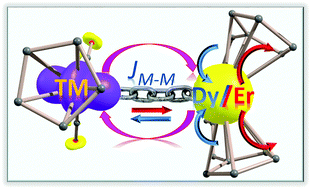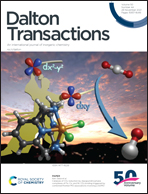Are lanthanide-transition metal direct bonds a route to achieving new generation {3d–4f} SMMs?†
Abstract
Lanthanide based single-molecule magnets are gaining wide attention due to their potential applications in emerging technologies. One of the main challenges in this area is quenching quantum tunnelling of magnetisation (QTM), which often undercuts the magnetisation reversal barrier. Among the several strategies employed, enhancing exchange coupling has been studied in detail, with large exchanges resulting in stronger quenching of QTM effects. Lanthanides, however, suffer from weak exchanges offered by the deeply buried 4f orbitals and the numerous attempts to enhance the exchange coupling in the {3d–4f} pairs have not exceeded values larger than 30 cm−1. In this work, using a combination of DFT and the ab initio CASSCF/RASSI-SO method, we have explored lanthanide-transition metal direct bonds as a tool to quench QTM effects. In this direction, we have modelled [PyCp2LnMCp(CO)2] (Ln = Gd(III), Dy(III), and Er(III) and M = V(0), Mn(0), Co(0) and Fe(I) and here PyCp2 = [2,6-(CH2C5H3)2C5H3N]2− using [PyCp2DyFeCp(CO)2] as an example as reported by Nippe et al. (C. P. Burns, X. Yang, J. D. Wofford, N. S. Bhuvanesh, M. B. Hall and M. Nippe, Angew. Chem., Int. Ed. 2018, 57, 8144). Bonding analysis reveals a dative Ln–TM bond with a donation of π(V/Mndxy–π*CO) to 5dz2 (Gd) in the case of Gd–V and Gd–Mn and 4s(Co) to 5dxy/5dyz (Gd) for Gd–Co with the transition metal ion being found in the low-spin S = ½ configurations in all the cases. B3LYP/TZV (Gd;CSDZ) calculations on [PyCp2GdMCp(CO)2] yield JGd–V = −46.1 cm−1, JGd–Mn = −57.1 cm−1, JGd–Co = +55.3 cm−1, JGd–Fe+ = +13.9 cm−1, JGd–Vhs = −162.1 cm−1 and JGd–Mnhs = −343.9 cm−1 and unveiling record-high J values for {3d–4f} complexes. The mechanism of magnetic coupling is developed, which discloses the dominating presence of strong 3d–4f orbital overlaps in most of the cases studied, leading to antiferromagnetic exchange. When these overlaps are weaker and 3d to Gd(5dz2), charge transfer dominates, yielding a ferromagnetic coupling for the Gd–Co/Gd–Fe+ complexes. Calculations performed on the anisotropic Dy(III) and Er(III) complexes reveal that the ground state gzz axis lies along the Cp–Ln–Cp axis and the Ln–TM bonds, respectively. Thus the Ln–TM bond hinders the single-ion anisotropy of Dy(III) by offering equatorial ligation and lowering the mJ = ±½ state energy, and at the same time, helping in enhancing the axiality of Er(III). When strong {3d–4f} exchange couplings are introduced, record-high barrier heights as high as 229 cm−1 were accomplished. Furthermore, the exchange coupling annihilates the QTM effects and suggests the lanthanide-transition metal direct bond as a viable alternative to enhance exchange coupling to bring {3d–4f} complexes back in the race for high-blocking SMMs.

- This article is part of the themed collection: Spotlight Collection: Lanthanide and transition metal complexes as molecular magnets


 Please wait while we load your content...
Please wait while we load your content...